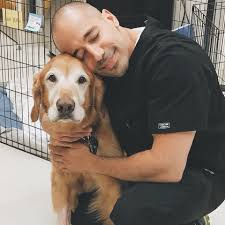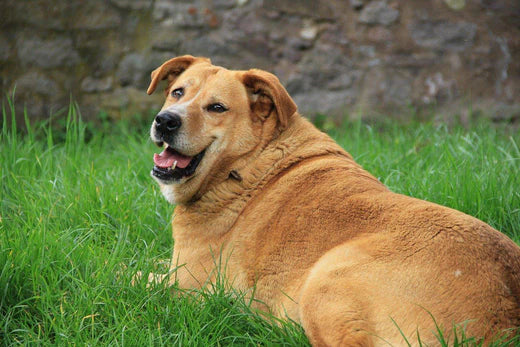By Pet Pro Supply Co. Featured Veterinarian,
Dr. Shadi Ireifej DVM DACVS
Co-founder and Chief Medical Officer at VetTriage

Is your Yorkie a little porky?
Does your Lab have too much flab?
Is your feline not so streamline(d)?
Despite the cheesy puns, canine obesity is a serious issue for pet parents in the US. Over time, we have managed to change what is considered the “normal” size and shape of our pets. And, once your beloved pet has exceeded their normal weight, it becomes very difficult to get back to where they’re supposed to be.
That’s where your veterinarian comes in! With advice from your friendly neighborhood pet doctor, and some strict commitment on your part, we can get Fluffy to look more lean. Don’t try to go it alone!
Though up to 40% of dogs in the US are considered overweight, this problem is not just ours. For instance, 30% of dogs in Japan and Australia are considered overweight. Obesity is not just for the dogs, either! Up to 35% of cats are also considered obese in the US. These figures are certainly alarming.
Now, don’t get me wrong – it’s not all the pet parents’ fault. Besides just “lifestyle” (which pet parents do control), there are certainly other reasons that have caused our pooches to become too “poochy.” Hormonal diseases and genetics also play a role with this issue – which is why it’s important to get a veterinarian involved if your pet is obese. But, since your pet’s lifestyle plays the biggest role in his or her weight, there are definitely things we can do in their day to day to fight this all-too-common disease.
You, as the pet parent, controls what goes in your pet’s dish. Just like us, dogs are going to follow the path of least resistance to get fed – naturally, most dogs these days don’t hunt for their food! They rely on you. They aren’t hiding snacks under the dog dish or in the corner of their dog house to “cheat.” They count on you to decide what’s best to eat, and in what amount! And just like you, “they are what they eat.”
The principles we are going to talk about are going to hit very close to home for many pet parents. I have seen over the years the reflection of the owner’s lifestyle evident through their pet’s body condition. I have seen plenty of overweight pet parents that also have overweight pets. In fact, I also see too many diabetic owners that also have a diabetic dog. Coincidence? I think not!
Obesity always causes problems down the line for pets, even if the problems are not visible at first. You’ve probably heard your family veterinarian tell you this or even warn you when they notice that your dog has begun to gain weight over the years. Kidney disease, cardiac disease, liver disease, joint disease and pancreatic disease all can result from carrying too much weight. By far the two biggest morbidities, however, are arthritis and diabetes. All of these conditions not only affect your pet’s quality of life, but also their longevity!
The solution? There are TWO ways to fight this disease and I guarantee everyone out there has tried to modify their own lives with these methods.
The main one: it’s all about calorie intake and daily activity! That’s right! “Diet and Exercise.” The same two factors that your own doctor barks at you about also apply to man’s best friend. It’s that easy and that difficult at the same time.
Our goal is to lose 20% of our pet’s weight over 6 months’ time, on average. How much food do we cut out? There are plenty of very specific caloric intake formulas out there that are beyond the scope of this article. As a general rule, though, most obese pets are 20% above their ideal weight. So to figure out the new daily amount to feed our pet, we take what’s on the bag of dog food and decrease it by 20% overall per day.
Hate percentages? Me too! This is why I developed “Dr. Shadi’s Rule of 20s”: most pets are 20% overweight, we want to lose 20% of the weight over 6 months, and we begin by cutting the recommended daily intake by 20%. Simple!
Here’s an example…
Let’s say your dog’s current weight is 150 lbs. We will assume an ideal weight of 120 lbs by taking that current weight, multiplying it by 20% and subtracting that amount from that current body weight. That means we are looking for a 30 lb weight loss regimen that results in losing about 5 lbs in each month. As such this will take us about 6 months before we reach our ideal weight. This is a slow process with dogs, as it is with people! There’s no magic way about it.
If you look at a standard good quality bag of dry dog food, it will recommend what a dog weighing 120 lbs should be fed. We will take that number, multiply it by 20%, subtract that number from the dog food company’s recommendation and voila! We have our new daily total feeding intake.
But here is something most people and maybe even veterinarians forget about. It’s not just the amount of food you’re putting in, but in what frequency. Ever hear the expression “keep the fire burning?” That’s not just true for relationships, folks! It’s true in weight loss programs too. It implies that if we slowly add to a fire as the day goes on, we can keep a nice steady fire going all day. This is in comparison to throwing on a large load of wood in the morning and a large load at night to try to keep the fire going. Because in between the morning and night, the fire will be small and in danger of going out, while during the times of “feeding the fire,” the flames will be huge.
Our metabolism works in the same manner. Eating small meals frequently keeps our metabolism burning all day at a nice steady pace. This results in less insulin spikes, less unnecessary bouts of hunger, and a better response to exercise. So not only are we going to decrease the amount we feed your dog, but we are also going to distribute that new amount over 3 or 4 meals a day, instead of the usual one or two. Make sense?
As we already mentioned, daily activity also plays a role. Certainly this is easier to do if you live on the coast of San Diego where the weather is consistently 75 degrees year-round. But seeing as how we’ve established that obesity can mean life or death for your four-legged family member, it should be a commitment we all stand by!
I always recommend making the exercise regimen a routine for two – you and your dog. Exercise in itself is healthy, of course, but especially if you’re looking to lose weight, then it’s great to do it with a four-legged partner. Everyone knows it’s more fun to workout with a friend – and what better friend than our furry pals who never complain!
For dogs with more severe obesity, do multiple shorter walks more frequently (even if just a few minutes). Increase the walks by 5 minutes every week. See how far this takes the two of you! Just remember: always stay hydrated and if your canine partner decides it’s time to stop, then be sure to listen! Once your dog is in better shape, you can do less walks and increase the length of each walk, up to 30 minutes each.
Remember also to keep your veterinarian involved in the process, and do a formal evaluation after 6 months. Your dogtor can also suggest modifications to your dog’s weight loss plan and also create a weight maintenance plan. Once your dog has lost the weight, make sure to keep it off!
Getting your dog to a healthy weight, you’ll see that Sparky will have a lot more spark. With dedication and hard work you can both lead a healthier lifestyle, minimizing organ problems and keeping your beloved companion around for much, much longer!
Check out Pet Pro Supply Co.’s collection of products that help with Pet Diabetes!

About Dr. Shadi Ireifej:
Dr. Shadi Ireifej DVM DACVS is the Chief Medical Officer at VetTriage. He holds degrees from SUNY Binghamton and Cornell University and has practiced as a veterinary surgeon all across the United States. Follow him on Instagram @dr.shadi.ireifej and subscribe to his YouTube channel (Dr. Shadi Ireifej).
About VetTriage:
VetTriage is the world’s foremost provider of veterinary telehealth services. With VetTriage, pet owners have immediate access to triage advice from licensed veterinarians. Follow them on Instagram @vettriage and Facebook (facebook.com/televeterinarian).




